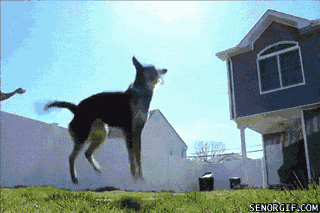

Pocket Beagles are so cool so why don't you have a look at some facts about them!
#1. "A hardy, sturdy squarely-built, small hound."
#2. "The Pocket Beagle has a sleek, easy-care, short coat, which can come in any hound color, for example, tri-color, black and tan, red and white, orange and white, or lemon and white. The coat is close, hard and of medium length."
#3. "The Pocket Beagle looks like a small English Foxhound."
#4. "The skull is broad and slightly rounded."
#5. "The feet are round and strong."
#6. "The black nose has full nostrils for scenting."
#7. "The long, wide ears are pendant."
#8. "The brown or hazel eyes have a characteristic pleading expression."
#9. "The tail is carried gaily, but never curled over the back."
#10. "Pocket Beagles have a distinct howl / bay of a bark when they are on the hunt."
#11. "The Pocket Beagle is a gentle, sweet, lively and curious dog that just loves everyone!"
#12. "A happy little tail-wagger!"
#13. "Sociable, brave and intelligent."
#14. "Calm and loving."
#15. "Excellent with children and generally good with other dogs, but should not be trusted with non-canine pets, unless they are socialized with cats and other household animals when they are young."
#16. "Pocket Beagles have minds of their own."
#17. "They are determined and watchful and require patient, firm training along with a true pack leader."
#18. "This breed doesn't like being left alone."
#19. "Consider buying two if you will be gone a lot."
#20. "To avoid separation anxiety, be your dogs pack leader, and make sure your dog gets enough meaningful exercise, such as a pack walk, along with nose exercises where he can use his hunting instincts."
#21. "A Pocket Beagle has a loud baying cry that was a delight to hunting horsemen, but can be disturbing to family and neighbors."
#22. "Pocket Beagles have a tendency to follow their own noses."
#23. "They may take off on their own exploration if let off their leash in an unfenced area."
#24. "Height: 7-12 inches (18-30 cm.)"
#25. "Weight: 7-15 pounds (3-7 kg.)"
#26. "Some lines can be prone to heart disease, epilepsy, eye and back problems. Also prone to chondroplasia, aka dwarfism (warped front legs, like a Basset's)."
#27. "Pocket Beagles will do okay in an apartment if they get plenty of chances to be outdoors. They are very active indoors and a small yard will be sufficient."
#28. "Energetic and possessing great stamina, the Pocket Beagle needs plenty of exercise, which includes a daily walk. A yard of reasonable size will take care the rest of its requirements. Always use a lead when walking this breed or you will be running the risk of it disappearing in search of wild game."
#29. "Life Expectancy: About 12-15 years."
#30. "Litter Size: 2 - 14 puppies - Average 7."
#31. "The Pocket Beagle's smooth short-haired coat is easy to look after. Brush with a firm bristle brush, and bathe with mild soap only when necessary. Dry shampoo occasionally. Be sure to check the ears carefully for signs of infection and keep the nails trimmed. This breed is an average shedder."
#32. "A smaller version of the standard Beagle. The smaller Beagle originated in England. Used as a hunting dog, it could travel under shrubs, brush and bushes and were used to hunt small animals such as rabbits. The name Old English Pocket Beagle originated because the hunters would carry the dogs in their saddle bags. It is said these original small size Beagles have become extinct, however they have been re-created and are now being bred once again."
Info and pics from: http://www.dogbreedinfo.com/p/pocketbeagle.htm







